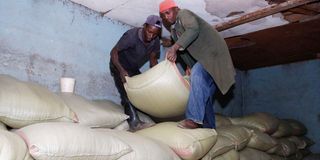Control of pests in stored maize grains

Workers arrange bags of dry maize in a store in Elburgon town, Nakuru County. The commodity is sourced from Oloitoktok in Kajiado County.
For the last eight months, we have been looking at the production of maize on Farmer Moses' farm.
We have gone through the full circle, from planting to harvesting. Today, we look at pest and disease prevention and control in stored maize grain.
Most of the post-harvest losses farmers incur are due to pests and diseases following reduction in the quality of the harvested produce.
A farmers' skills and knowledge in the identification, prevention and control of pests are important as this enables him to reduce the post-harvest losses, which lower the profit margin.
In maize production, weevils are the most common pests that affect the grain during storage. They are a small snout beetle. They vary from dull red-brown to nearly black, with a minimum life cycle of 28 days.
They start in the field where the female lays eggs in a tiny hole on the maize seed. The hatched larva bores thin tunnels beneath the seed coat, leaving circular holes on the surface of the grain. This renders the maize unmarketable.
The best approach to avoiding pest issues with stored grains is prevention. Prior to introducing new grains, maintain proper store sanitation to reduce the need for pesticides. Old grain must be removed, and grain stores cleaned and dusted to maintain good hygiene.
Insect infestations
This include cleaning any spilled grain on the store's floor as well as removing old ones from walls and corners. Any grain that remains in the store may cause insect infestations.
Timely harvesting prevents the attack of maize by weevils. Grain that is to be stored for longer than six months may need a protective application of an approved insecticide. This is usually done after shelling and before storage. Before applying the insecticide, the maize should be well-dried. The use of insecticides to control the weevils should be the last option and a supplementary measure.
Other pests that affect maize include rodents, which feed on the grains and significantly reduce the nutritional value.
In addition, grain contaminated by rodent droppings harbours pathogens, making it unfit for human consumption. Rodents can be controlled by ensuring the store is well-cleaned and maintain good hygiene around the store.
Poor storage can result in aflatoxins in maize. Aflatoxins are toxic chemicals produced by the fungus Aspergillus flavus, which occur naturally in the soil. During harvesting, one should ensure the seed coat is not damaged to end up with clean grains.
This is because damage to the seed coat enhances the development of aflatoxins.
During storage, one should avoid storing maize in high-moisture areas for long periods as it absorbs water.
Also, while drying the maize, use high temperatures as slow drying with low heat for a longer period results in the development of aflatoxin. Store the maize in a cool and dry place.
In our next article, we shall look at the lessons learnt in farmer Moses' maize production.




